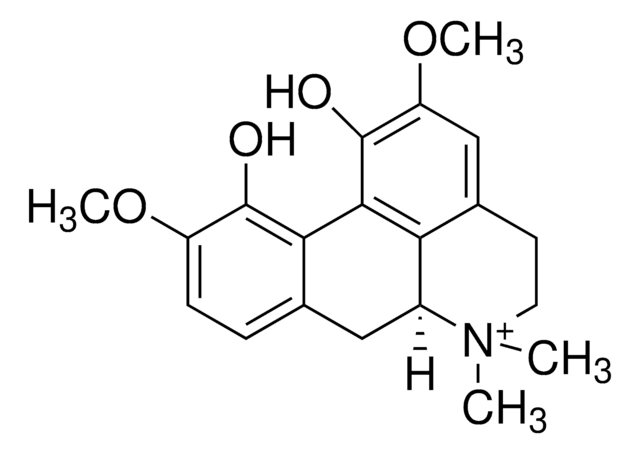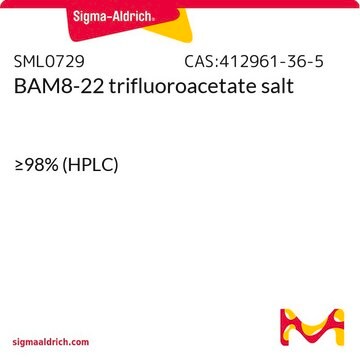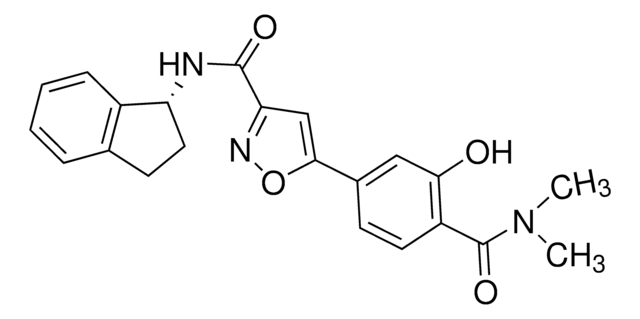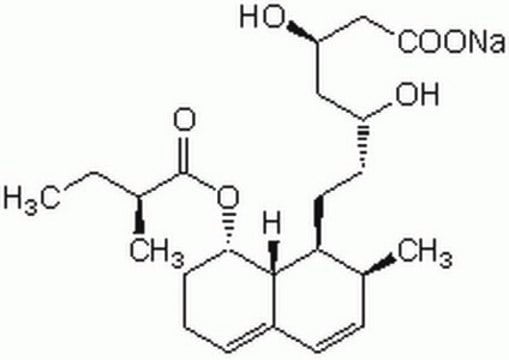SML0610
Nitidine chloride
≥97% (HPLC)
Synonym(s):
2,3-Dimethoxy-12-methyl-[1,3]benzodioxolo[5,6-c]phenanthridinium chloride, NSC 146397
About This Item
Recommended Products
Assay
≥97% (HPLC)
form
powder
color
white to beige
solubility
DMSO: 1 mg/mL, clear (warmed)
shipped in
wet ice
storage temp.
−20°C
SMILES string
C[N+]1=CC2=CC(OC)=C(OC)C=C2C3=CC=C4C=C5C(OCO5)=CC4=C31.[Cl-]
InChI
1S/C21H18NO4.ClH/c1-22-10-13-7-17(23-2)18(24-3)8-15(13)14-5-4-12-6-19-20(26-11-25-19)9-16(12)21(14)22;/h4-10H,11H2,1-3H3;1H/q+1;/p-1
InChI key
QLDAACVSUMUMOR-UHFFFAOYSA-M
Looking for similar products? Visit Product Comparison Guide
Biochem/physiol Actions
Features and Benefits
Signal Word
Danger
Hazard Statements
Precautionary Statements
Hazard Classifications
Acute Tox. 2 Oral
Storage Class Code
6.1A - Combustible acute toxic Cat. 1 and 2 / very toxic hazardous materials
WGK
WGK 3
Flash Point(F)
Not applicable
Flash Point(C)
Not applicable
Certificates of Analysis (COA)
Search for Certificates of Analysis (COA) by entering the products Lot/Batch Number. Lot and Batch Numbers can be found on a product’s label following the words ‘Lot’ or ‘Batch’.
Already Own This Product?
Find documentation for the products that you have recently purchased in the Document Library.
Articles
The focal adhesion kinase (FAK) is a cytoplasmic protein tyrosine kinase. FAK has been implicated as a downstream signaling molecule that functions in the control of several integrin-regulated biological processes.
The focal adhesion kinase (FAK) is a cytoplasmic protein tyrosine kinase. FAK has been implicated as a downstream signaling molecule that functions in the control of several integrin-regulated biological processes.
The focal adhesion kinase (FAK) is a cytoplasmic protein tyrosine kinase. FAK has been implicated as a downstream signaling molecule that functions in the control of several integrin-regulated biological processes.
The focal adhesion kinase (FAK) is a cytoplasmic protein tyrosine kinase. FAK has been implicated as a downstream signaling molecule that functions in the control of several integrin-regulated biological processes.
Our team of scientists has experience in all areas of research including Life Science, Material Science, Chemical Synthesis, Chromatography, Analytical and many others.
Contact Technical Service






![Dibenzo[a,l]pyrene BCR®, certified reference material](/deepweb/assets/sigmaaldrich/product/structures/937/930/3e2321b0-d54a-46c2-bb84-007bb57eb381/640/3e2321b0-d54a-46c2-bb84-007bb57eb381.png)


